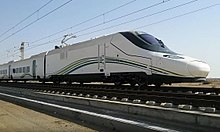Rail transport in Saudi Arabia is an expanding mode of transport.[1]
| Rail transport in Saudi Arabia | |||||
|---|---|---|---|---|---|
 | |||||
| Operation | |||||
| National railway | Saudi Arabia Railways | ||||
| Track gauge | |||||
| Main | 1,435 mm (4 ft 8+1⁄2 in) | ||||
| |||||
Saudi Arabia Railways is the national railway operator. The Saudi Railways Organization was also formerly a major operator, however it was merged into the Saudi Railway Company (now Saudi Arabia Railways) in 2021.[2]
History
editThe first railway in Arabia was the Hejaz Railway, constructed by the Ottoman Empire from the Damascus to Medina.[3] This 1,050 mm (3 ft 5+11⁄32 in) narrow gauge railway opened in 1908, but closed in 1920 due to the Arab Revolt.
Modern railways were introduced in Saudi Arabia after World War II, to facilitate the transport of goods for the Arabian American Oil Company, or Aramco (now Saudi Aramco), from ports located on the coast of the Persian Gulf to warehouses in Dhahran. Construction began in September 1947, and the first line was inaugurated on 20 October 1951. Several development projects have been completed since then, including an extension of the line to Riyadh, construction of several passenger terminals, and the opening of a dry port in Riyadh.[4]
The Saudi Railways Organization was merged into the new Saudi Arabia Railways on 1 April 2021.
In Riyadh an extensive metro system is under construction from 2014, with six lines of 176 km (110 miles) all due to open in 2023. Rolling stock will be from Siemens, Alstom and Bombardier. One line in Saudi Arabia, an 18km (11 mile) line from Makka, Mecca operates for only one week a year for pilgrims only during the annual Hajj pilgrimage. It uses 17 twelve-car Chinese EMUs. An automated 11.5 km (7 miles) elevated metro to the Princess Nourah Bint Abdulrahman University for Women in Riyadh, uses 22 two-car trains built in Italy by Ansaldo Breda in 2011-12 and is operated by Hitachi Rail. It is only accessible to women. Advertisements for 32 women driver trainees (in a country where women could not drive cars until fairly recently) attracted 28,000 women applicants! To cope with the heat and drifting sand, locomotives are fitted with sophisticated air filtration and cooling systems - and sand ploughs. [5]
Network
editHaramain High Speed Railway
editThe Haramain High Speed Railway opened to the public on 11 October 2018; it links the Muslim holy cities of Medina and Mecca via the King Abdullah Economic City and Jeddah. The line was designed for a top speed of 350 km/h (220 mph), and with a service speed of 300 km/h (190 mph).
Saudi Landbridge
editA new railway, called the Saudi Landbridge, will connect Jeddah on the Red Sea coast with the Saudi Arabian capital Riyadh.[6]
Dammam–Riyadh line
editThe Dammam–Riyadh line links Dammam with Riyadh. The passenger line started operation in 1981 and is 449 km long, and has four stations. It was formerly operated by the Saudi Railways Organization.
Riyadh–Qurayyat Line
editThe Riyadh–Qurayyat line was built in 2012 and opened in 2017; it begins at Riyadh and runs northwest toward Al Haditha near the Jordanian border, passing through Majma’a, Qassim, Hail and Al-Jawf.[7] Both passenger and freight services are operating on this line.[8] There are six passenger stations on the line which are in Riyadh at King Khaled International Airport, Majma’a, Qassim, Hail at Prince Abdulaziz Bin Mussa’ad Economic City, Al-Jawf, and Al-Qurayyat.[7]
North-South line
editThe North-South line runs from Al-Jalamid mine in the Northern province and then passes through Al-Jawf and Hail until Al Baithah Junction in Qassim province. The line then travels east to the processing and export facilities in Ras Al Khair in the Eastern Province.[7] This line will be used solely by freight trains.[9][8]
Rail links to adjacent countries
editSame gauge (1,435 mm (4 ft 8+1⁄2 in)
edit- United Arab Emirates — no connection, proposed as part of the Gulf Railway
- Qatar — no connection, proposed as part of the Gulf Railway
- Oman — no connection, proposed as part of the Gulf Railway
- Bahrain — no connection, proposed as part of the Gulf Railway
- Kuwait — no connection, proposed as part of the Gulf Railway
- Iraq — proposed
Break-of-gauge (1,050 mm (3 ft 5+11⁄32 in)
edit- Jordan — North–South line terminates in Al-Haditha, close to the border
See also
editReferences
edit- ^ Briginshaw, David (September 18, 2015). "CAF presents first passenger train to Saudi Railway Company".
- ^ "سياسي / مجلس الوزراء يعقد جلسته ـ عبر الاتصال المرئي ـ برئاسة خادم الحرمين الشريفين وكالة الأنباء السعودية". www.spa.gov.sa.
- ^ Daradkeh, Saleh Musa (June 11, 2014). "The Hijaz Railway". In Ababsa, Myriam (ed.). Atlas of Jordan : History, Territories and Society. Contemporain publications. Presses de l’Ifpo. pp. 205–208. ISBN 9782351594384 – via OpenEdition Books.
- ^ "Establishment". Saudi Railways. Archived from the original on 2020-02-01. Retrieved 2023-01-29.
- ^ Trains of the Desert in "The Railway Magazine" (UK); No 1,465, April 2023, Volume 169, pages 32-35
- ^ "Saudi Railways Expansion Programme". Archived from the original on 2008-01-13.
- ^ a b c "Project Overview". Saudi Arabia Railways. Archived from the original on 2015-10-29.
- ^ a b "SAR Railway Network Map". Saudi Arabia Railways. Archived from the original on 2013-07-23.
- ^ Shaw-Smith, Peter (16 May 2011). "Saudi Landbridge rail project loses momentum". www.ft.com. Retrieved 22 August 2023.
